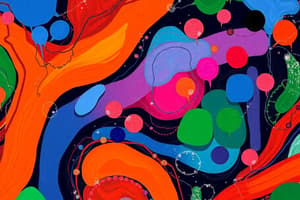Podcast
Questions and Answers
What happens when phospholipids are placed in water?
What happens when phospholipids are placed in water?
A phospholipid bilayer is formed.
What are integral proteins?
What are integral proteins?
Partially in or fully span the bilayer.
What are peripheral proteins?
What are peripheral proteins?
Located on the inner or outer surface of the bilayer.
What is the phospholipid bilayer?
What is the phospholipid bilayer?
What is the function of transporters in membrane proteins?
What is the function of transporters in membrane proteins?
What is the role of enzymes in membrane proteins?
What is the role of enzymes in membrane proteins?
What do attachment proteins do?
What do attachment proteins do?
What is the purpose of cell-cell recognition proteins?
What is the purpose of cell-cell recognition proteins?
What do intercellular joining proteins do?
What do intercellular joining proteins do?
What is signal transduction in membrane proteins?
What is signal transduction in membrane proteins?
What is passive transport?
What is passive transport?
What is active transport?
What is active transport?
What is simple diffusion?
What is simple diffusion?
What is facilitated diffusion?
What is facilitated diffusion?
What are channel proteins?
What are channel proteins?
What are ion channels?
What are ion channels?
What do carrier proteins do?
What do carrier proteins do?
What is osmosis?
What is osmosis?
What is a solution?
What is a solution?
What is a solute?
What is a solute?
What is hypertonic?
What is hypertonic?
What is hypotonic?
What is hypotonic?
What is isotonic?
What is isotonic?
What happens when an animal cell is placed in a hypertonic solution?
What happens when an animal cell is placed in a hypertonic solution?
What is crenation?
What is crenation?
What happens when a plant cell is placed in a hypertonic solution?
What happens when a plant cell is placed in a hypertonic solution?
What is plasmolysis?
What is plasmolysis?
What happens when an animal cell is placed in a hypotonic solution?
What happens when an animal cell is placed in a hypotonic solution?
What is hemolysis?
What is hemolysis?
What happens when a plant cell is placed in a hypotonic solution?
What happens when a plant cell is placed in a hypotonic solution?
What is turgor pressure?
What is turgor pressure?
What happens when a cell is placed in an isotonic solution?
What happens when a cell is placed in an isotonic solution?
What is the sodium potassium pump?
What is the sodium potassium pump?
What is coupled transport?
What is coupled transport?
Flashcards are hidden until you start studying
Study Notes
Phospholipids and Membrane Structure
- When phospholipids are placed in water, they form a bilayer with hydrophilic heads in contact with water and hydrophobic tails facing inward.
- Membrane flexibility varies: saturated fats make membranes less flexible, while unsaturated fats increase flexibility. Cholesterol reduces overall membrane flexibility.
Membrane Proteins
- Integral Proteins: Span the phospholipid bilayer, either partially or fully embedded.
- Peripheral Proteins: Located on the inner or outer surface of the bilayer and do not penetrate the membrane.
Functions of Membrane Proteins
- Transporters: Control the passage of specific substances in and out of cells, allowing selective movement.
- Enzymes: Speed up chemical reactions at the membrane surface.
- Attachment: Connect cells to the extracellular matrix (ECM) and cytoskeleton, stabilizing the cell structure.
- Cell-Cell Recognition: Serve as identification tags for cells, facilitating cell communication.
- Intercellular Joining: Enable attachments between neighboring cells.
- Signal Transduction: Relay signals from the environment to the cell's interior, triggering responses.
Transport Mechanisms
-
Passive Transport: Moves substances naturally from high to low concentration without using cellular energy. Types include:
- Simple Diffusion: Direct movement through the membrane; spontaneous and energy-free.
- Facilitated Diffusion: Requires a protein to assist substances in crossing the membrane.
- Osmosis: Specific diffusion of water across a semi-permeable membrane from high to low water concentration.
-
Active Transport: Requires energy to move substances against their concentration gradient, from low to high concentration.
Types of Proteins in Facilitated Diffusion
- Channel Proteins: Create a pore or tunnel for substances to pass through.
- Ion Channels: Specialized channels for ions, which can open and close to regulate ion passage.
- Carrier Proteins: Bind to specific substances (e.g., sugars and amino acids) to transport them across the membrane.
Solutions and Concentration Types
- Solution: A mixture of a solvent and solute.
- Solute: The substance that dissolves in a solvent.
- Hypertonic: Higher solute concentration leading to lower water concentration.
- Hypotonic: Lower solute concentration resulting in higher water concentration.
- Isotonic: Equal concentration of solutes in comparison to another solution.
Cell Behavior in Different Solutions
-
Hypertonic Solutions:
- Animal cells lose water, resulting in crenation; cells may die.
- Plant cells undergo plasmolysis where the membrane pulls away from the cell wall.
-
Hypotonic Solutions:
- Animal cells take in water, swell, and may experience hemolysis (bursting).
- Plant cells swell and maintain turgor pressure, becoming firm due to water pressure in the vacuole.
-
Isotonic Solutions: Water moves in and out at a constant rate; animal cells remain normal while plant cells become limp.
Sodium-Potassium Pump and Coupled Transport
- Sodium-Potassium Pump: Actively transports 3 sodium ions out of the cell and 2 potassium ions into the cell, maintaining low sodium and high potassium concentrations inside.
- Coupled Transport: Simultaneously transports two different substances across the membrane, utilizing energy to move one substance out while bringing another in.
Studying That Suits You
Use AI to generate personalized quizzes and flashcards to suit your learning preferences.




